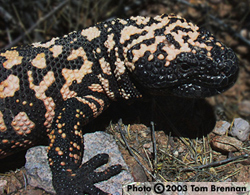



Above left: Image copyright © A.T. Holycross. Sceloporus magister (Desert Spiny Lizard), Coconino County, AZ. Above right: Image copyright © 2003 Tom Brennan. Heloderma suspectum (Gila Monster), Pima County, AZ.

 This unit's content provided by Arizona Partners in Amphibian and Reptile Conservation, AZPARC.
This unit's content provided by Arizona Partners in Amphibian and Reptile Conservation, AZPARC. Unit Description
- Summary: This unit provides an overview of lizard biology culminating in the "Life as a Lizard" role playing game. The game gives students a chance to move around indoors or outdoors, and use their movement to learn about lizards and their behavior. Participants take on the identities of lizards and act out a day and night in the life of many different species of lizard. There are no winners or losers, only the successful completion of a day and night as a lizard. The game's props are easily made and the unit contains step by step lessons, glossary words, background information, internet and multimedia resources, trivia activities, and suggestions for math extensions and additonal student investigations.
For information about grade level, education standards, time frame and more please see the following section.
Learning Resource Information
- ToL Learner Level: Beginner; Intermediate
- Student Grade Level: Grades 3 through 12. Not all the information is appropriate for every audience and lessons should be adapted and/or included according to teacher and student preference.
- Time frame: This unit can take from two to three class periods of ~45 minutes or it can be spread out over two weeks with ~ 45 minutes of time spent daily.
- Curricular Areas: Science, Language Arts, Reading
- Learning Styles: Physical activity, role playing, hands-on
- Key Science Concepts: Evolution, Geographic distribution, Adaptation, Foraging Patterns, Animal Behavior, Predator Prey Relationships, Habitats, Characteristics of Lizards
- Unit Learning Objectives: (individual lessons will have additional objectives)
- To introduce students to lizard biology.
- To identify and describe different species of lizards that live in the Sonoran Desert.
- To understand predator/prey interactions.
- To understand the importance of lizards in nature.
- To foster a feeling of stewardship towards the organisms that live around us.
- To introduce the specifics of desert lizard ecology and biological communities.
- State Education Standards: View all State Education Standards available for this Unit
- National Education Standards: View all National Education Standards available for this Unit
Lesson Plans, Activities and More
Follow the links below to access lesson plans and activities. Materials listed for these lessons are available in the "ToL Learning Materials" section of each page. Not every part of the unit needs to be completed, feel free to modify the timeline, omit or add pieces as you see fit. Items marked with an *asterisk are deemed necessary for playing the life as a lizard game. You can add additional learning resources to the unit by registering as a treehouse builder.
- Part 1: Introduce Lizards, Build Context and Vocabulary Includes:
- Lesson 1.1 ~ 30 min. *Introduce the Life as a Lizard Unit.
- Lesson 1.2 ~ 45 min. Lizard Behavior: Mini Field Trip and Practicing Role Playing.
- Lesson 1.3 ~ 45 min. *Life as a Lizard Glossary Words
- Part 2: Research and Preparation Includes:
- Lesson 2.1 ~ 45 min. *Assign and Review Lizard, Predator and Prey Roles (Give out Cast Cards).
- Lesson 2.2 ~ 1hr. Gathering More Information - Researching Lizard Roles
- Lesson 2.3 Student Role Playing Preparation Activities
- Part 3: Making Props and Playing the Life as a Lizard Game Includes:
- Lesson 3.1~ 45 min. *Preparing the Props: Making Tails and other items
- Lesson 3.2 ~ 45 min. Create Lizzie Awards
- Lesson 3.3 ~ 1 to 1.5 hrs. *Prepare the Physical Space and Play the Game!
- Part 4: Suggested Extensions
- Under Construction
- Become a treehouse contributor and create a treehouse on lizards. Your treehouse can be an investigation, game, story, art and culture piece or a teacher resource.
Learning Materials
- Lizard, Predator and Prey Species List
- Life as a Lizard Glossary Words
- Key Word Fun Memory Game
- Glossary Word Worksheet
- Lizard Behavior Chart
- Life as a Lizard Interview Questions
- An Introduction to Lizards
- An Introduction to Lizards Questions Not Yet Available
- Life as a Lizard Props and Preparation
- Life as a Lizard Action Cards
- Life as a Lizard Game Cast Cards: Lizards
- Life as a Lizard Game Cast Cards: Predators and Prey
- Life as a Lizard Game Instructions
- Life as a Lizard Lizzie Award activity
Information on the Internet
- An AZPARC page with images and information about Phrynosoma solare, Regal horned lizard
- An AZPARC page with images and information about Sceloporus magister, Desert Spiny Lizard
- An AZPARC page with images and information about Dipsosaurus dorsalis, Desert Iguana
- An AZPARC page with images and information about Sauromalus obesus, Common Chuckwalla
- An AZPARC page with images and information about Aspidoscelis sonorae, Sonoran Spotted Whiptail
- An AZPARC page with images and information about Coleonyx variegatus, Western Banded Gecko
- An AZPARC page with images and information about Heloderma suspectum, Gila Monster
- An AZPARC page with images and information about Sceloporus clarkii, Clark's Spiny Lizard
- An AZPARC page with images and information about Callisaurus draconoides, Zebra-tailed Lizard
- An AZPARC page with images and information about Urosaurus ornatus, Tree Lizard
- An AZPARC page with images and information about Uta stansburiana, Common Side-blotched Lizard



 Go to quick links
Go to quick search
Go to navigation for this section of the ToL site
Go to detailed links for the ToL site
Go to quick links
Go to quick search
Go to navigation for this section of the ToL site
Go to detailed links for the ToL site